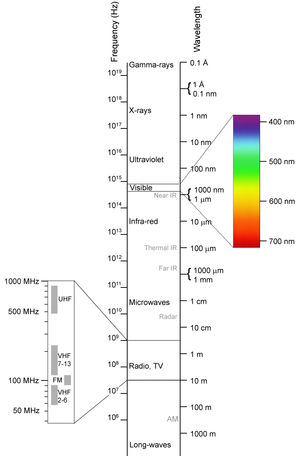 The electromagnetic spectrum is the range of all possible frequencies of electromagnetic radiation. The "electromagnetic spectrum" of an object is the characteristic distribution of electromagnetic radiation emitted or absorbed by that particular object.
The electromagnetic spectrum is the range of all possible frequencies of electromagnetic radiation. The "electromagnetic spectrum" of an object is the characteristic distribution of electromagnetic radiation emitted or absorbed by that particular object.
The electromagnetic spectrum extends from low frequencies used for modern radio communication to gamma radiation at the short-wavelength (high-frequency) end, thereby covering wavelengths from thousands of kilometers down to a fraction of the size of an atom. It is for this reason that the electromagnetic spectrum is highly studied for spectroscopic purposes to characterize matter. The limit for long wavelength is the size of the universe itself, while it is thought that the short wavelength limit is in the vicinity of thePlanck length,although in principle the spectrum is infinite and continuous.
 Propagation: Electromagnetic Waves are interactions of electric and magnetic fields perpendicular to each other. This enables the propagation of the waves even in vacuum. The velocity of the EM wave is always a constant which is equal to 299,792,458 m/s or simply 3 x 10^8m/s or approx. 186,282 miles/s.
Propagation: Electromagnetic Waves are interactions of electric and magnetic fields perpendicular to each other. This enables the propagation of the waves even in vacuum. The velocity of the EM wave is always a constant which is equal to 299,792,458 m/s or simply 3 x 10^8m/s or approx. 186,282 miles/s.
Thus for different waves, there are ranges of frequencies and wavelengths, the velocity of light being given by
c = fλ,
where c is velocity of light,
f = frequency of the wave &
λ = wavelength of the wave.
On the basis of frequencies and wavelengths, the EM radiations is divided into different types of radiations.
c = fλ,
where c is velocity of light,
f = frequency of the wave &
λ = wavelength of the wave.
On the basis of frequencies and wavelengths, the EM radiations is divided into different types of radiations.
Types of Radiations:
- Gamma radiation
- X-ray radiation
- Ultraviolet radiation
- Visible radiation
- Infrared radiation
- Microwave radiation
- Radio waves





0 comments:
Post a Comment